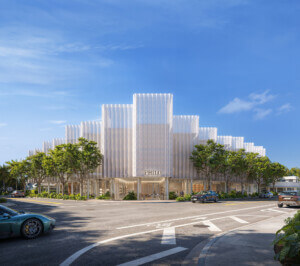British firm Foster + Partners has submitted new plans to Miami city authorities for what—if approved—will be the tallest building south of Manhattan along the East Coast. Officially known as “The Towers” (really?) the project sees two rectilinear structures rising up from the Brickell waterfront, with the tallest of the pair reaching 1,049 feet. In compliance with density constrictions from the City of Miami’s Miami 21 zoning code, the two towers will hold 660 living units—a 16 percent decrease on the initially proposed 787. The structures’ heights, however, have not been an issue with Federal Aviation Administration: The organization has already granted the project approval.
At the building’s base, car parking areas have been divided in two and are encased by retail areas and more living units. This layout diverges from the standard singular “monolithic” car parking podium typical to Miami (car garages are a big deal in the city). According to the firm, this “frees up space at the ground level” and “creates an engaging public realm.” Furthermore, The Towers’ relationship to the site at street level sees restaurants, cafes, and art gallery spaces laid out inside a tropical garden. 56,800 square feet of the 2.5-acre scheme will be publicly accessible.
“The base of the building continues the axis of SE 12th Terrace, drawing life back to the bay. It is a civic response to the city’s enlightened vision, and will make an important contribution to Miami’s public spaces,” said Norman Foster, chairman and founder of Foster + Partners.
As both towers rise up, the structure has been stepped back and thinned to allow sufficient daylight to enter the vicinity around the base while preserving views out to sea. With that height in such a location, though, comes the issue of high winds. To counter this, strategic planting and adjustable louvres that can be lowered over a central plaza will act as wind breakers. To cope with extreme weather conditions, belt beam bracings (also used to support bridge apartments that span the tower floor plates) will tie the towers together ensuring they can withstand hurricanes.










